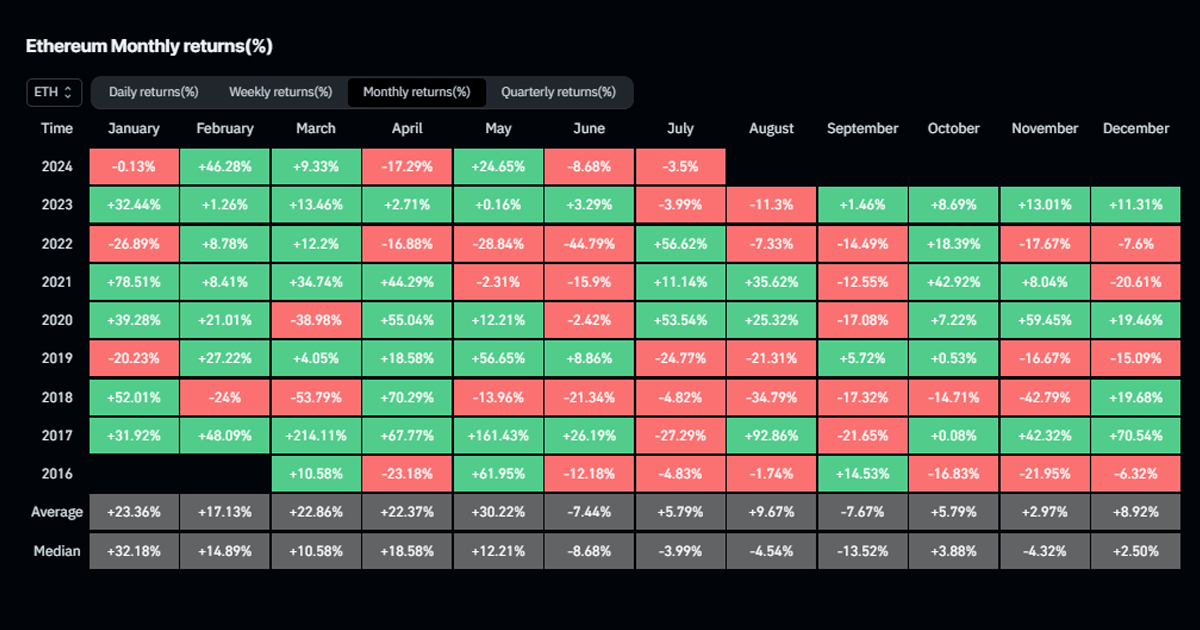Ethereum
MIT brothers accused of mining Ethereum to steal $25 million

Many cryptocurrency traders are playing fast and loose with the systems in place to bolster decentralized finance (DeFi), using a variety of hacks to gain an advantage in their trades – from sandwich attacks to sweepstakes scams – and losses typically amount to tens of millions. dollars per month.
Yet two traders – brothers who both graduated from the Massachusetts Institute of Technology – took their plan too far, exploiting a vulnerability in a common component used by traders on the Etherium blockchain to make nearly $25 million in a attack that lasted 12 seconds, the U.S. Department of Justice charged on May 16. The two brothers — Anton Peraire-Bueno of Boston and James Peraire-Bueno of New York — discovered the software flaw in 2022, prepared and planned the attacks for months, then executed the theft in April. 2023, say law enforcement.
The attack worried traders and technologists, calling into question “the very integrity of blockchain,” Damian Williams, U.S. Attorney for the Southern District of New York, said in a statement. a statement from the Department of Justice announcing the indictment.
“The brothers, who studied computer science and mathematics at one of the most prestigious universities in the world, allegedly used their specialized skills and education to alter and manipulate the protocols that millions of data users rely on. “Ethereum across the world,” he said. “And once they put their plan into action, their heist lasted only 12 seconds. This alleged scheme was new and has never been charged before.”
Cryptocurrency has gained legitimacy over the past fifteen years, but continues – in many ways – to be a Wild West. In 2023, over $24 billion in transactions ended up in illicit cryptocurrency wallets or addresses – although more than half of the total belonged to sanctioned organizations and countries, and the total fraud rate is only 0.34%, according to Chainalysis, a blockchain intelligence firm.
While ransomware gangs prefer Bitcoin, Ethereum has seen its share of attacks, since the $60 million DAO hack in 2016 this led to a hard fork – a rewrite of the Ethereum ledger – towards the over $600 million in Ethereum stolen from Ronin network players.
In many ways, the ecosystem behind cryptocurrencies is suffering from the growing challenges that the Internet has faced over the past three decades, says Oded Vanunu, chief Web 3.0 technologist and head of product vulnerability research at within the cybersecurity company Check Point Software Technologies.
“It’s crazy, because we’re seeing tactics already implemented on Web 2 platforms that take a different form in Web 3 protocols,” he says.
Memory pools and maximum extractable value
Cryptocurrency transfers, the proposal of a smart contract, and the execution of smart contracts are all transactions recorded on the blockchain — in the case of Ethereum, a public distributed state machine. However, before being recorded, each transaction is placed in a memory pool, or memory poolwhile waiting for validation and execution, which usually takes a few steps.
A participant in the ecosystem known as a “block builder” will create a set – or block – of transactions and be paid by the initiator of each transaction for its completion, while a “block proposer” will choose blocks according to the costs announced by the manufacturer. , validates them and sends these transactions to its peers on the blockchain network. Typically, a builder attempts to structure blocks based on a maximum extractable value (MEV) strategy, seeking to maximize profits.
Dividing participants into proposers and builders – what is called a proposer-builder split (PBS) – divides the responsibility for validating transactions to limit monopolization of the process by large traders who might order transactions in specific ways to generate profits. MEV bots help traders identify and create trade sets that maximize their profits on a trade.
Yet there is still much traders can do to tip the scales. In a sandwich attack, for example, the trader benefits from natural price increases or decreases caused by large cryptocurrency transactions. When a large buy order appears, a manufacturer can place a buy order for the cryptocurrency before the order, and a corresponding sell order afterward, thereby taking advantage of the price change caused by the initial buy order. .
For many DeFi participants, MEV traders are little better than the equivalent of modern-day ticket scalpers, but they play a vital role, says Adam Hart, product manager at Chainalysis.
“To many, MEV strategies look like hyper-sophisticated, deep-pocketed traders using their resources to profit by forcing less sophisticated traders to accept worse prices,” he says. “However, others argue that MEV is inevitable in an open and transparent blockchain network, and that MEV traders play a positive role in ensuring that arbitrage opportunities are exploited quickly so that asset prices remain aligned between protocols.”
An attack on MEV traders
The Peraire-Bueno brothers discovered a vulnerability in an open source component of a common tool, known as MEV-Boost Relay, according to a post-mortem analysis of the incident. MEV-Boost is a protocol aimed at limiting the centralization of the two components of the Ethereum blockchain – the proposers and the builders – and the monopolization of profits, which could have historically led to a few players dominating the blockchain process.
A key criterion of the MEV-Boost protocol is that the proposer undertakes to validate a block according to the price, before knowing its content. The brothers reportedly discovered that signing the header gave them the information contained in the block, even if the signature was not valid, the autopsy stated.
“The attack…was possible because the exploited relay revealed block bodies to the submitter, provided the submitter correctly signed a block header,” the analysis states. “However, the relay did not check whether the signed block header was valid.”
Although the vulnerability could have continued to cause problems for traders, it was not an attack directly against the Ethereum network or its validators, but rather against a specific – albeit common – third-party component, explains Mario Rivas, manager global blockchain security practices. at NCC Group.
“The attack exploited a vulnerability in the relay code, which caused the relay to send private transactions to the block builder when it signed a block with invalid headers,” he explains. “This vulnerability was quickly fixed, mitigating the risk of similar attacks unless additional vulnerabilities are identified.”
Law enforcement achieves victory
The investigation and indictment, however, constitute a victory for the DOJ. American law enforcement is increasingly cracking down on scams, hacking and other questionable practices linked to cryptocurrencies. In August, for example, the U.S. Securities and Exchange Commission accused correctional officer of creating worthless cryptocurrency and sell it to other members of law enforcement.
Yet other attacks have fallen short of the threshold for prosecution. In one 2021 attack, for example, a trader admitted to selling an illiquid token to a rival – in what is known as a salmonella attack – and making money through the automated system of his rival by buying the worthless coin, according to a Forbes report.
The brothers’ alleged attack stands out from these controversial tactics, says Check Point’s Vanunu.
“In essence, while both types of attacks are harmful, the MIT brothers’ actions were explicitly illegal due to their direct and unauthorized exploitation of the vulnerabilities to steal funds, whereas [a] Salmonella attack lever[s] market manipulation and deception, staying within the darkest confines of legality in the crypto world,” he says.
The investigation into this scheme and subsequent indictment underscore that government officials and their private partners are keeping pace with the latest innovative attacks. Despite the sophistication of the exploit and the laundering of the proceeds, investigators traced the funds, identified two suspects and made their arrests, Chainalysis’ Hart said.
“The exploit by the Peraire-Bueno brothers is an incredibly innovative and technically sophisticated attack, and is the first time a bad actor has managed to abuse the MEV system widely used by Ethereum block builders in this way and at this degree,” he said. . “This is what makes this indictment so impressive and a promising sign for the future in the fight against cryptocurrency-based crime.”
Ethereum
QCP sees Ethereum as a safe bet amid Bitcoin stagnation

QCP, a leading trading firm, has shared key observations on the cryptocurrency market. Bitcoin’s struggle to surpass the $70,000 mark has led QCP to predict Selling pressure is still strong, with BTC likely to remain in a tight trading range. In the meantime, Ethereum (ETH) is seen as a more promising investment, with potential gains as ETH could catch up to BTC, thanks to decreasing ETHE outflows.
Read on to find out how you can benefit from it.
Bitcoin’s Struggle: The $70,000 Barrier
For the sixth time in a row, BTC has failed to break above the $70,000 mark. Bitcoin is at $66,048 after a sharp decline. Many investors sold Bitcoin to capitalize on the rising values, which caused a dramatic drop. The market is becoming increasingly skeptical about Bitcoin’s rise, with some investors lowering their expectations.
Despite the continued sell-off from Mt. Gox and the US government, the ETF market remains bullish. There is a notable trend in favor of Ethereum (ETH) ETFs as major bulls have started investing in ETFs, indicating a bullish sentiment for ETH.
QCP Telegram Update UnderlinesIncreased market volatility. The NASDAQ has fallen 10% from its peak, led by a pullback in major technology stocks. Currency carry trades are being unwound and the VIX, a measure of market volatility, has jumped to 19.50.
The main factors driving this uncertainty are Value at Risk (VaR) shocks, high stock market valuations and global risk aversion sentiment. Commodities such as oil and copper have also declined on fears of an economic slowdown.
Additionally, QCP anticipates increased market volatility ahead of the upcoming FOMC meeting, highlighting the importance of the Federal Reserve’s statement and Jerome Powell’s subsequent press conference.
A glimmer of hope
QCP notes a positive development in the crypto space with an inflow of $33.7 million into ETH spot ETFs, which is giving a much-needed boost to ETH prices. However, they anticipate continued outflows of ETHE in the coming weeks. The recent Silk Road BTC moves by the US government have added to the market uncertainty.
QCP suggests a strategic trade involving BTC, which will likely remain in its current range, while ETH offers a more promising opportunity. They propose a trade targeting a $4,000-$4,500 range for ETH, which could generate a 5.5x return by August 30, 2024.
Ethereum
Ethereum Whale Resurfaces After 9 Years, Moves 1,111 ETH Worth $3.7 Million

An Ethereum ICO participant has emerged from nearly a decade of inactivity.
Lookonchain, a smart on-chain money tracking tool, revealed On X, this long-inactive participant recently transferred 1,111 ETH, worth approximately $3.7 million, to a new wallet. This significant move marks a notable on-chain movement, given the participant’s prolonged dormancy.
The Ethereum account in question, identified as 0xE727E67E…B02B5bFC6, received 2,000 ETH on the Genesis block over 9 years ago.

This initial allocation took place during the Ethereum ICOwhere the participant invested in ETH at around $0.31 per coin. The initial investment, worth around $620 at the time, has now grown to millions of dollars.
Recent Transactions and Movements
The inactive account became active again with several notable output transactions. Specifically, the account transferred 1,000 ETH, 100 ETH, 10 ETH, 1 ETH, and 1 more ETH to address 0x7C21775C…2E9dCaE28 within a few minutes. Additionally, it moved 1 ETH to 0x2aa31476…f5aaCE9B.
Additionally, in the latest round of transactions, the address transferred 737,995 ETH, 50 ETH, and 100 ETH, for a total of 887,995 ETH. These recent activities highlight a significant movement of funds, sparking interest and speculation in the crypto community.
Why are whales reactivating?
It is also evident that apart from 0xE727E67E…B02B5bFC6, other previously dormant Ethereum whales are waking up with significant transfers.
In May, another dormant Ethereum whale made headlines when it staked 4,032 ETHvalued at $7.4 million, after more than two years of inactivity. This whale initially acquired 60,000 ETH during the Genesis block of Ethereum’s mainnet in 2015.
At the time, this activity could have been related to Ethereum’s upgrade known as “Shanghai,” which improved the network’s scalability and performance. This whale likely intended to capitalize on the price surge that occurred after the upgrade.
Disclaimer: This content is informational and should not be considered financial advice. The opinions expressed in this article may include the personal opinions of the author and do not reflect the opinion of The Crypto Basic. Readers are encouraged to conduct thorough research before making any investment decisions. The Crypto Basic is not responsible for any financial losses.
-Advertisement-
Ethereum
Only Bitcoin and Ethereum are viable for ETFs in the near future

BlackRock: Only Bitcoin and Ethereum Are Viable for ETFs in the Near Future
Bitcoin and Ethereum will be the only cryptocurrencies traded via ETFs in the near future, according to Samara Cohen, chief investment officer of ETFs and indices at BlackRock, the world’s largest asset manager.
In an interview with Bloomberg TV, Cohen explained that while Bitcoin and Ethereum have met BlackRock’s rigorous criteria for exchange-traded funds (ETFs), no other digital asset currently comes close. “We’re really looking at the investability to see what meets the criteria, what meets the criteria that we want to achieve in an ETF,” Cohen said. “Both in terms of the investability and from what we’re hearing from our clients, Bitcoin and Ethereum definitely meet those criteria, but it’s going to be a while before we see anything else.”
Cohen noted that beyond the technical challenges of launching new ETFs, the demand for other crypto ETFs, particularly Solana, is not there yet. While Solana is being touted as the next potential ETF candidate, Cohen noted that the market appetite remains lacking.
BlackRock’s interest in Bitcoin and Ethereum ETFs comes after the successful launch of Ethereum ETFs last week, which saw weekly trading volume for the crypto fund soar to $14.8 billion, the highest level since May. The success has fueled speculation about the next possible ETF, with Solana frequently mentioned as a contender.
Solana, known as a faster and cheaper alternative to Ethereum, has been the subject of two separate ETF filings in the US by VanEck and 21Shares. However, the lack of CME Solana futures, unlike Bitcoin and Ethereum, is a significant hurdle for SEC approval of a Solana ETF.
Despite these challenges, some fund managers remain optimistic about Solana’s potential. Franklin Templeton recently described Solana as an “exciting and major development that we believe will drive the crypto space forward.” Solana currently accounts for about 3% of the overall cryptocurrency market value, with a market cap of $82 billion, according to data from CoinGecko.
Meanwhile, Bitcoin investors continue to show strong support, as evidenced by substantial inflows into BlackRock’s iShares Bitcoin Trust (NASDAQ: IBIT). On July 22, IBIT reported inflows of $526.7 million, the highest single-day total since March. This impressive haul stands in stark contrast to the collective inflow of just $6.9 million seen across the remaining 10 Bitcoin ETFs, according to data from Farside Investors. The surge in IBIT inflows coincides with Bitcoin’s significant $68,000 level, just 8% off its all-time high of $73,000.
Ethereum
Ethereum Posts First Consecutive Monthly Losses Since August 2023 on New ETFs

Available exclusively via
Bitcoin ETF vs Ethereum: A Detailed Comparison of IBIT and ETHA
Andjela Radmilac · 3 days ago
CryptoSlate’s latest market report takes an in-depth look at the technical and practical differences between IBIT and BlackRock’s ETHA to explain how these products work.
-

 Ethereum12 months ago
Ethereum12 months agoEthereum Posts First Consecutive Monthly Losses Since August 2023 on New ETFs
-

 Regulation12 months ago
Regulation12 months agoCryptocurrency Regulation in Slovenia 2024
-

 News12 months ago
News12 months agoNew bill pushes Department of Veterans Affairs to examine how blockchain can improve its work
-

 Regulation12 months ago
Regulation12 months agoThink You Own Your Crypto? New UK Law Would Ensure It – DL News
-

 Regulation12 months ago
Regulation12 months agoUpbit, Coinone, Bithumb Face New Fees Under South Korea’s Cryptocurrency Law
-

 Regulation12 months ago
Regulation12 months agoA Blank Slate for Cryptocurrencies: Kamala Harris’ Regulatory Opportunity
-

 Regulation12 months ago
Regulation12 months agoBahamas Passes Cryptocurrency Bill Designed to Prevent FTX, Terra Disasters
-

 Regulation12 months ago
Regulation12 months agoIndia to Follow G20 Policy for Cryptocurrency Regulation: MoS Finance
-

 News1 year ago
News1 year ago“Captain Tsubasa – RIVALS” launches on Oasys Blockchain
-

 Ethereum1 year ago
Ethereum1 year agoComment deux frères auraient dérobé 25 millions de dollars lors d’un braquage d’Ethereum de 12 secondes • The Register
-

 News12 months ago
News12 months agoEU supports 15 startups to fight online disinformation with blockchain
-

 News1 year ago
News1 year agoSolana ranks the fastest blockchain in the world, surpassing Ethereum, Polygon ⋆ ZyCrypto





